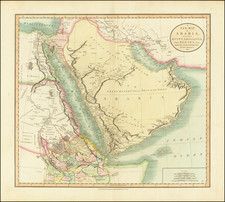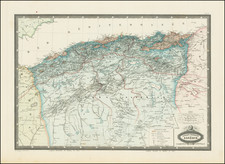Fine example of this rare map of the Bay of Tunis, illustrating the Siege of July 1574.
The engraving depicts the Bay of Tunis during the siege by the Turks in July 1574 at the Goletta.
Siege of Tunis
In 1574, William of Orange and Charles IX of France, through his pro-Huguenot ambassador François de Noailles, Bishop of Dax, tried to obtain the support of the Ottoman ruler Selim II in order to open a new front against the Spanish king Philip II. Selim II sent his support through a messenger, who tried to put the Dutch in contact with the rebellious Moriscos of Spain and the pirates of Algiers. Selim also sent a great fleet to attack Tunis in the Autumn of 1574, thus succeeding in reducing Spanish pressure on the Dutch.
In the Battle of La Goleta, Selim II organized a fleet of between 250 and 300 warships, with about 75,000 men. The Ottoman fleet was commanded by Sinan Pacha and Alūj Ali. The Ottoman fleet combined with troops sent by the governors of Algiers, Tripoli and Tunis, giving a combined strength of about 100,000. The army attacked Spanish held ports of Tunis and La Goleta. The Spanish presidio of La Goleta, then defended by 7,000 men, fell on August 24, 1574. The last Christian troops in a small fort opposite Tunis surrendered on September 3, 1574.
John of Austria attempted to relieve the siege with a fleet of galleys from Naples and Sicily but failed due to storms. The Spanish crown, being heavily involved in the Netherlands and short of funds was unable to help significantly.
Miguel Cervantes participated in these events as a soldier, and was among the troops of Don Juan of Austria which tried to rescue the city. He claims that the Ottomans led 22 assaults against the fort of Tunis, losing 25,000 men, while only 300 Christians survived. He wrote about the battle:
If Goleta and the fort, put together, held barely 7,000 soldiers, how could such a small force, however resolute, come out and hold its own against so huge an enemy army. And how can you help losing a stronghold that is not relieved, and especially when it is surrounded by a stubborn and very numerous army, and on its own ground?
— Cervantes, DQ I, 39.[2]
Abd al-Malik, the future Moroccan King, participated in the 1574 conquest of Tunis on the side of the Ottomans
The capture of Tunis gave the territories of the Hafsid dynasty to the Ottoman Empire. The battle marked the final establishment of Ottoman rule in Tunis, putting an end to the Hafsid dynasty and the Spanish presence in Tunis.
The success of the Turks under Occhiali in the battle of Goleta managed in reducing Spanish pressure on the Dutch, and leading to negotiations at the Conference of Breda. After the death of Charles IX in May 1574 however, contacts weakened, although the Ottomans are said to have supported the 1575–1576 revolt, and establish, in 1582, a Consulate in Antwerp (De Turks-Griekse Natie). The Ottomans made a truce with Spain, and shifted their attention to their conflict with Persia in the Ottoman–Safavid War (1578–1590). The Spanish crown fell into bankruptcy in September 1575.
Rarity
Bifolco-Ronca locate 5 examples of the map (Atlante Aragona; Milano, Raccolta Bertarelli; Parigi, Bibliotheque Nationale; Roma, Biblioteca Apostolica Vaticana; Wolfenbuttel, Herzog August Bibliothek).









![[Azores and Cape Verde Islands to West Africa & Spain] Barbariae et Guineae Maritimi a Freto Gibraltar ad Fluvium Gambiae cum Insulis Salsi Flandricis et Canaricis](https://storage.googleapis.com/raremaps/img/small/74954.jpg)

![[Capture of Mahdia in 1550] Vera urbis Africae descriptio, p Illust. D. Viceregem Sicilae, & Antonium Doriam, Caroli. v. Imper inuictiss. Duces iam expugnatae. 1550](https://storage.googleapis.com/raremaps/img/small/78592.jpg)
![Barbary and Bildulgerid. [on sheet with:] Egypt and Barca &c.](https://storage.googleapis.com/raremaps/img/small/70916.jpg)

